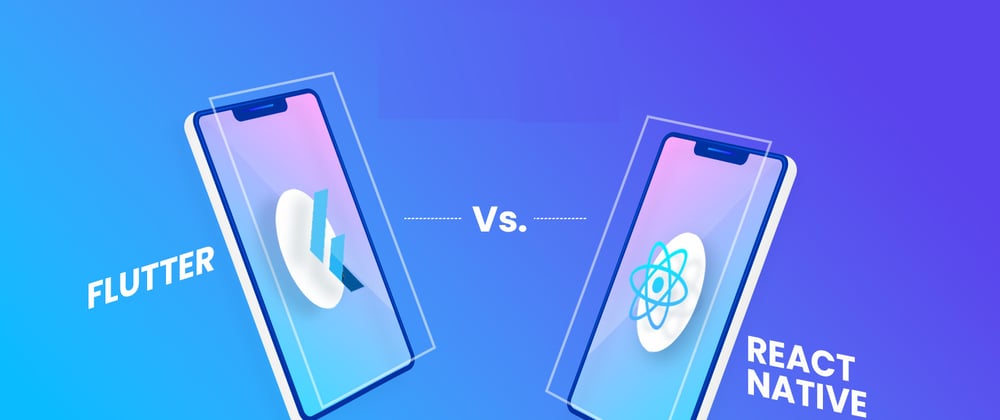React Native and Flutter are the most popular mobile app development frameworks. However, both frameworks have their advantages and disadvantages. And depending upon the use cases, it can take a lot of work to select from the two.
In this article, we will look at Flutter and React Native and compare them on various factors.
Introduction
Flutter was first announced at the 2015 Dart developer summit and launched in 2017. It was created by Google. It uses the Dart programming Language and is an open-source mobile application development framework.
The open source framework is commonly used to build different applications for websites, desktops, and mobile from a single codebase.
React Native is also an open-source mobile application framework. It was created by Facebook and was launched in March 2015. The open-source framework lets developers build native mobile apps using the React library and JavaScript.
Programming language
Flutter uses the Dart programming language, developed by Google specifically for use with the Flutter framework. Dart is an object-oriented language that is easy to learn for developers with experience in other C-style languages such as Java or C#.
On the other hand, React Native uses JavaScript, one of the world's most widely-used programming languages, making it easier for developers to find developers with JavaScript experience.
Performance
Flutter makes use of Skia – a rendering engine. It's also used by Gmail and Google Chrome. This unique rendering engine gives direct access to the native components of the device and draws UI directly on the canvas. Direct access results in smooth and fast performance.
React Native uses a bridge to communicate with the native components of the device. In other words, the app has to send data through the data to give some performance overhead.
Recently, the overhead performance issue has been solved and is minimal.
Development time
Building apps with Flutter takes less time. That's because it has a rich set of pre-designed tools and widgets to create good-looking and functional apps.
It also has a hot reload that lets devs view the changes in real-time. Thus, making the development process smoother and more efficient.
React Native also has a hot reload. But it has a limited set of pre-defined tools and widgets. Developers must use third-party libraries or build their libraries, which adds more development time.
Support and Community
Flutter and React Native have a large community with many resources to support the developers.
Since Flutter is backed by Google, it has many resources and great documentation.
The community and resources of React Native are similar to Flutter. But it's not backed by a large company.
Architecture
Flutter uses a reactive programming model, which means that the framework responds to user input and updates the app's state in real time. This allows for a smooth and responsive user experience.
React Native, on the other hand, uses a more traditional, imperative programming model similar to the model used in web development.
UI
Flutter has more customizable widgets that allow for greater user interface flexibility. In addition, the widgets in Flutter are rendered directly by the framework, which allows for more detailed control over the look and feel of the app.
React Native uses native components to render the UI, which can make it more difficult to achieve a consistent look and feel across different platforms.
Testing
Flutter and React Native offer powerful testing features, but they are implemented differently.
Flutter has a built-in testing framework that allows developers to write unit tests, widget tests, and integration tests. In addition, this framework makes it easy to test the entire app, including the UI, logic, and database.
On the contrary, React Native relies on external libraries like Jest and Enzyme for testing. While these libraries are powerful, they may require more setup and configuration than Flutter's built-in testing framework.
Support for web and desktop
Flutter has experimental web and desktop development support using a single codebase, allowing developers to share code between mobile and web platforms. This means that developers can create a single app that runs on multiple platforms, saving time and resources.
React Native does not have official support for web and desktop development. However, some third-party libraries and frameworks make it possible to use React Native for web and desktop development. However, this can be a more complex process and require additional setup and configuration.
Access to Native Features
React Native allows developers to access native features of the device, such as camera, GPS, and Bluetooth, using native modules. This means that developers can create apps that use the device's native functionality without writing platform-specific code.
Flutter also allows this, but it does not have as many pre-built plugins for it as React Native does. This means developers may need more time building custom plugins to access native features.
Design and Flexibility
React Native provides more flexibility when designing the user interface, allowing developers to use native components and third-party libraries. This means developers can create apps that look and feel like native apps on different platforms.
While Flutter also has a rich set of customizable widgets, it may be limited in terms of design and flexibility when compared to React Native. This may mean that developers will have to spend more time customizing the widgets to achieve the desired look and feel.
Platform-specific code
React Native allows developers to write platform-specific code using the "Platform module," which detects the platform the app is running on. This allows developers to write code specific to iOS or Android and make changes accordingly.
On the other hand, Flutter uses a single codebase for iOS and Android, meaning developers don't have to write platform-specific code.
Animation and Gestures
Flutter has built-in animation and gestures support, making creating smooth and responsive animations and transitions easier.
React Native relies on third-party libraries and plugins for animation and gestures, which can make it more difficult to achieve the same level of performance and responsiveness.
Support for older devices
React Native may have better support for older devices as it uses a JavaScript bridge to communicate with native components, which can be optimized for older devices.
Flutter has compatibility issues with older devices as it requires more resources.
Ease of integration
React Native allows developers and react native development services to integrate easily with third-party libraries and APIs, using JavaScript, a widely-used language.
Flutter may be more difficult to integrate with third-party libraries and APIs as it uses Dart, which is less commonly used.
Size of the app
The app size built using React Native may be larger than that built using Flutter. This is because React Native uses a JavaScript bridge to communicate with native components, which can increase the size of the app.
Flutter compiles the Dart code to native code, which can result in smaller app sizes. The flutter app development company mainly uses this.
To wrap up
Flutter and React Native are powerful frameworks for building mobile apps, but they have some key differences.
Both frameworks have advantages and disadvantages. The best choice for a particular project will depend on the project's specific requirements, the experience and skill set of the development team, and other factors. Hence, it's best to hire react native developers or opt for Flutter app development services to get the best consultation.







Top comments (0)